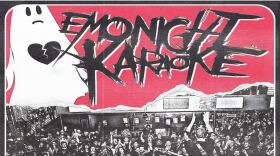Every Sunday morning throughout the summer, a bell rings out three times from an island in the middle of Squam Lake.
It's a signal that boaters, kayakers, and even swimmers, should begin to make their way to the island - because church is about to start.
With a granite boulder serving as an altar and music from a hand cranked organ, Chocurua Island has hosted religious services of all kinds for more than a hundred years. In this final installment of our summer series Surrounded, Sean Hurley visits the island, with one of its most devoted caretakers.
Editor's note: we recommend listening to this story
Along the water’s edge in Bennett Cove on Squam Lake, Margie Howe Emmons leads me to her boat. “So this is my yacht,” she says of her 15 hp dinghy. “Hold onto your hat. You might need a seat belt.”
It isn’t a yacht, I don’t have a hat, and there isn’t a seatbelt.
We glide out beyond Willoughby Point, past a spray of stones called Otter Islands - until Chocurua Island - “Church Island,” as it’s more commonly known - comes into view.
“It's dead ahead,” Howe Emmons says, “You can't see where because there's an island behind it.”
But through the trees I can see the white birch cross, the blue gray slats of the pews.
“I mean it's not just for Squam Lake, anybody can come,” she says.

Fifty yards from the string of docks that line the southern end of the island, the boat stalls. And as we drift in toward the docks at the speed of the lake itself, Howe Emmons says, “We have a different Minister every Sunday. And all different denominations.”
Throughout the summer there are Catholic Memorials, Jewish weddings, Pentecostal baptisms. “My grandparents, Howe grandparents,” she tells me, “were the first ones married out here in 1916.”

As we tie up and come ashore, Howe Emmons points to the open cliffs of Rattlesnake Mountain across the lake.
“I mean the number of kids who proposed to their spouses on the top of Rattlesnake and said ‘We're getting married on Church Island...’” she says. “My son for one. Heidi and Matthew.”
She brings me along the pine needle path to the chapel.
“This island housed the first boys camp ever in the United States,” she says, and tells me that it was those campers who made the first pews, who set out the granite boulder of the altar and pulled a twist of stone from the lake and installed it as the chapel’s reading lectern.
It’s been tended and cared for more than a century since then.

The three acre island is 600 feet long, 360 feet wide and the open air chapel sits at the northern end. Aside from the altar and the pews, there’s a stone baptismal font hidden among the blueberry bushes – a wooden tower housing the same bell from the camp days – and a small locked shed with a hand-cranked organ inside.
A one woman, one child operation, Howe Emmons says, with a kid cranking at the instruction of the female organist.
“So she's here and she usually has a stick from the woods and she – tap tap taps - and that means crank.”

I tap on the organ house window with a stick. Howe Emmons starts cranking and I start playing.
“I don't have a church,” she says, “you know another church. This pulls my heart and tugs at me all year round. I'm 71 years old and I've been here since I was two months old. You know it wasn't till my more adult life that I could probably really feel this place.”
What is the feel of this place, I ask her.
“Well it's an ultimate peacefulness,” she says, “and it's just God's place. I don't feel like, you know, a church religious person. I'm certainly spiritual and I'm a thinker and I think in this day and age - oof, like right now in our world? Lordy me it's really nice to be in a place where you don't feel, see, hear...any of it. You can see, feel, and hear whatever you like.”
And one of the things Margie Howe Emmons most likes to see, feel, and hear during mass is a kind of gentle disruption of the proceedings.
“The ultimate service for me is to have a loon just go by and call,” she says. “And the minister usually stops and listens.”

And all stop and listen, she says, as the church becomes a different kind of church. And the chapel on the island expands outward across the water.
For more information visit the Church Island website.








